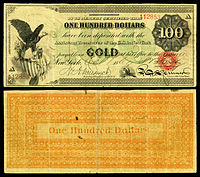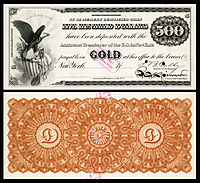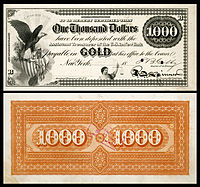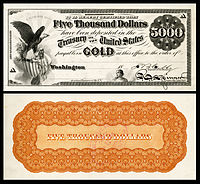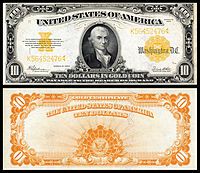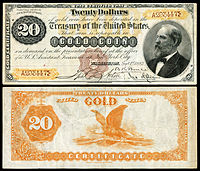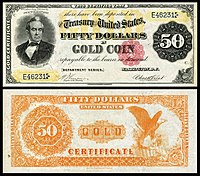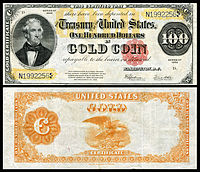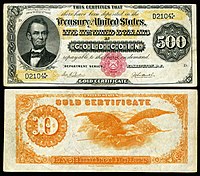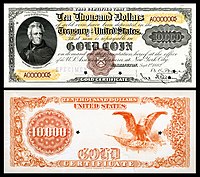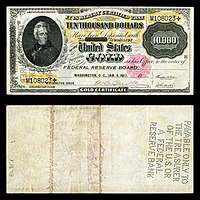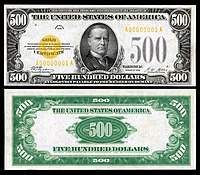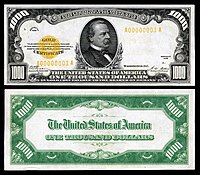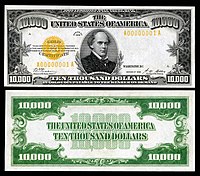Federal Reserve Notes, also United States banknotes, are the currently issued banknotes of the United States dollar. The United States Bureau of Engraving and Printing produces the notes under the authority of the Federal Reserve Act of 1913 and issues them to the Federal Reserve Banks at the discretion of the Board of Governors of the Federal Reserve System. The Reserve Banks then circulate the notes to their member banks, at which point they become liabilities of the Reserve Banks and obligations of the United States.
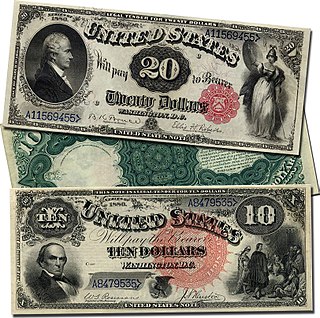
A United States Note, also known as a Legal Tender Note, is a type of paper money that was issued from 1862 to 1971 in the United States. Having been current for 109 years, they were issued for longer than any other form of U.S. paper money. They were known popularly as "greenbacks", a name inherited from the earlier greenbacks, the Demand Notes, that they replaced in 1862. Often termed Legal Tender Notes, they were named United States Notes by the First Legal Tender Act, which authorized them as a form of fiat currency. During the early 1860s the so-called second obligation on the reverse of the notes stated:
This Note is a Legal Tender for all debts public and private except Duties on Imports and Interest on the Public Debt; and is receivable in payment of all loans made to the United States.

The United States five-dollar bill ($5) is a denomination of United States currency. The current $5 bill features U.S. president Abraham Lincoln and the Great Seal of the United States on the front and the Lincoln Memorial on the back. All $5 bills issued today are Federal Reserve Notes. As of December 2018, the average life of a $5 bill in circulation is 4.7 years before it is replaced due to wear. Approximately 6% of all paper currency produced by the U.S. Treasury's Bureau of Engraving and Printing in 2009 were $5 bills.

The United States ten-dollar bill ($10) is a denomination of U.S. currency. The obverse of the bill features the portrait of Alexander Hamilton, who served as the first U.S. Secretary of the Treasury, two renditions of the torch of the Statue of Liberty, and the words "We the People" from the original engrossed preamble of the United States Constitution. The reverse features the U.S. Treasury Building. All $10 bills issued today are Federal Reserve Notes.

The United States fifty-dollar bill ($50) is a denomination of United States currency. The 18th U.S. president (1869-1877), Ulysses S. Grant, is featured on the obverse, while the U.S. Capitol is featured on the reverse. All current-issue $50 bills are Federal Reserve Notes.

The United States one-hundred-dollar bill ($100) is a denomination of United States currency. The first United States Note with this value was issued in 1862 and the Federal Reserve Note version was first produced in 1914. Inventor and U.S. Founding Father Benjamin Franklin has been featured on the obverse of the bill since 1914, which now also contains stylized images of the Declaration of Independence, a quill pen, the Syng inkwell, and the Liberty Bell. The reverse depicts Independence Hall in Philadelphia, which it has featured since 1928.
Large denominations of United States currency greater than $100 were circulated by the United States Treasury until 1969. Since then, U.S. dollar banknotes have been issued in seven denominations: $1, $2, $5, $10, $20, $50, and $100.

The United States one-dollar bill (US$1), sometimes referred to as a single, has been the lowest value denomination of United States paper currency since the discontinuation of U.S. fractional currency notes in 1876. An image of the first U.S. president (1789–1797), George Washington, based on the Athenaeum Portrait, a 1796 painting by Gilbert Stuart, is currently featured on the obverse, and the Great Seal of the United States is featured on the reverse. The one-dollar bill has the oldest overall design of all U.S. currency currently being produced. The reverse design of the present dollar debuted in 1935, and the obverse in 1963 when it was first issued as a Federal Reserve Note.

Silver certificates are a type of representative money issued between 1878 and 1964 in the United States as part of its circulation of paper currency. They were produced in response to silver agitation by citizens who were angered by the Fourth Coinage Act, which had effectively placed the United States on a gold standard. The certificates were initially redeemable for their face value of silver dollar coins and later in raw silver bullion. Since 1968 they have been redeemable only in Federal Reserve Notes and are thus obsolete, but still valid legal tender at their face value and thus are still an accepted form of currency.
The history of the United States dollar began with moves by the Founding Fathers of the United States of America to establish a national currency based on the Spanish silver dollar, which had been in use in the North American colonies of the Kingdom of Great Britain for over 100 years prior to the United States Declaration of Independence. The new Congress's Coinage Act of 1792 established the United States dollar as the country's standard unit of money, creating the United States Mint tasked with producing and circulating coinage. Initially defined under a bimetallic standard in terms of a fixed quantity of silver or gold, it formally adopted the gold standard in 1900, and finally eliminated all links to gold in 1971.
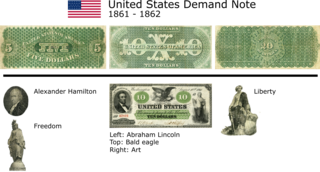
A Demand Note is a type of United States paper money that was issued from August 1861 to April 1862 during the American Civil War in denominations of 5, 10, and 20 US$. Demand Notes were the first issue of paper money by the United States that achieved wide circulation. The U.S. government placed Demand Notes into circulation by using them to pay expenses incurred during the Civil War including the salaries of its workers and military personnel.

National Gold Bank Notes were National Bank Notes issued by nine national gold banks in California in the 1870s and 1880s and redeemable in gold. Printed on a yellow-tinted paper, six denominations circulated: $5, $10, $20, $50, $100, and $500. A $1,000 note was designed and printed but never issued. During the issuing period of national gold banks (1871–83), the U.S. Treasury issued 200,558 notes totaling $3,465,240. Today, National Gold Bank Notes are rare in the higher denominations with condition generally falling in the good-to-fine range. Approximately 630 National Gold Bank Notes are known to exist, and roughly 20 grade above "very fine".
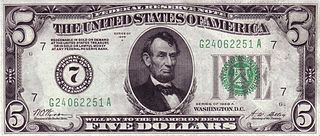
The Series of 1928 was the first issue of small-size currency printed and released by the U.S. government. These notes, first released to the public on July 10, 1929, were the first standardized notes in terms of design and characteristics, featuring similar portraits and other facets. These notes were also the first to measure 6.313" by 2.688", smaller than the large-sized predecessors of Series 1923 and earlier that measured 7.438" by 3.141".

Greenbacks were emergency paper currency issued by the United States during the American Civil War that were printed in green on the back. They were in two forms: Demand Notes, issued in 1861–1862, and United States Notes, issued in 1862–1865. A form of fiat money, the notes were legal tender for most purposes and carried varying promises of eventual payment in coin but were not backed by existing gold or silver reserves.
Bills of credit are documents similar to banknotes issued by a government that represent a government's indebtedness to the holder. They are typically designed to circulate as currency or currency substitutes. Bills of credit are mentioned in Article One, Section 10, Clause One of the United States Constitution, where their issuance by state governments is prohibited.

A Treasury Note is a type of short term debt instrument issued by the United States prior to the creation of the Federal Reserve System in 1913. Without the alternatives offered by a federal paper money or a central bank, the U.S. government relied on these instruments for funding during periods of financial stress such as the War of 1812, the Panic of 1837, and the American Civil War. While the Treasury Notes, as issued, were neither legal tender nor representative money, some issues were used as money in lieu of an official federal paper money. However the motivation behind their issuance was always funding federal expenditures rather than the provision of a circulating medium. These notes typically were hand-signed, of large denomination, of large dimension, bore interest, were payable to the order of the owner, and matured in no more than three years – though some issues lacked one or more of these properties. Often they were receivable at face value by the government in payment of taxes and for purchases of publicly owned land, and thus "might to some extent be regarded as paper money." On many issues the interest rate was chosen to make interest calculations particularly easy, paying either 1, 1+1⁄2, or 2 cents per day on a $100 note.
Banknotes of the United States dollar are currently issued as Federal Reserve Notes (1914–).
A silver certificate is a certificate of ownership that silver owners hold instead of storing the actual silver. Several countries have issued silver certificates, including Cuba, the Netherlands, and the United States. Silver certificates have also been privately issued by various mints and bullion companies. One example was the Liberty Dollar issued by NORFED from 1998 to 2009.

The United States two-dollar bill ($2) is a current denomination of United States currency. A portrait of Thomas Jefferson, the third president of the United States (1801–1809), is featured on the obverse of the note. The reverse features an engraving of John Trumbull's painting Declaration of Independence.
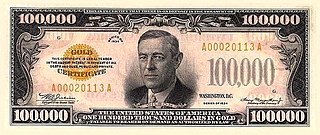
The United States one hundred thousand dollar bill (US$100,000) is a former denomination of United States currency, a gold certificate, issued for two years from 1934 to 1935 as designated for Federal Reserve use. The bill never circulated publicly, rather having been used as a large denomination note for gold transactions between Federal Reserve Banks. Featuring President Woodrow Wilson, the $100,000 bill was initiated by the Bureau of Engraving and Printing under the order of President Franklin D. Roosevelt in response to the hoarding of gold during the Great Depression, believed to be slowing economic regrowth. Executive Order 6102, signed by President Roosevelt, was ratified by the United States Congress in 1934. Executive Order 6102 prohibited the hoarding of gold certificates, accompanied also by bullion and coins.


